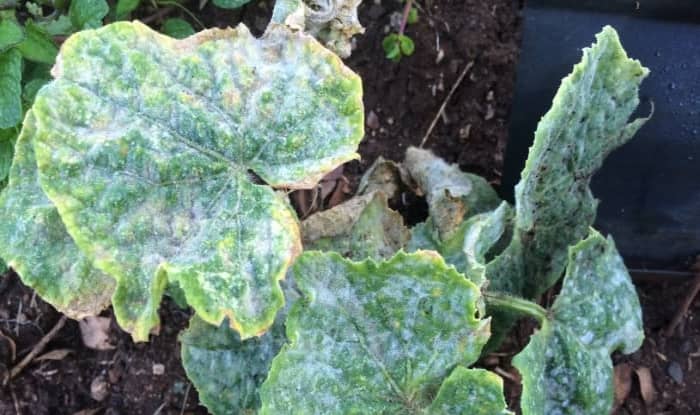Most people know that cucumber plants use a lot of water as they grow.
But unfortunately, this leads some people to overwater them.
When they’re sat in wet soil for extended periods of time it reduces oxygen uptake through their roots.
And the conditions encourage the growth of harmful fungi that can kill your plants.
In this article, we’ll take a look at the main symptoms and problems that occur if you’re overwatering your plants.
And we’ll give you some tips for dealing with the problem, as well as correct watering practices.
Let’s dive in.
Overwatered Cucumber Plants: Problems & Symptoms
These are the main symptoms and problems of overwatered cucumber plants:
The Leaves
Some of the most common signs of overwatering involve changes to the leaves.
When the roots are sat in waterlogged soil they’re susceptible to becoming damaged. Which affects their ability to absorb nutrients.
This leads to the cucumber plant leaves appearing discolored, turning yellow. You’ll also notice them droop and wilt. And eventually, they may fall off.
Another common symptom is the development of crispy brown edges and tips.
You see, water taken up by the cucumber plant travels through each leaf, cell to cell, due to a process called osmosis. Eventually, it reaches the outer edge of the leaf and has nowhere else to go.
If your plant is taking up too much water, the cells on the edges of the leaves swell and burst. Which creates the dead, brown edges that you can see.
Fungal Infections
Constant moisture promotes the growth of fungal pathogens such as powdery mildew and root rot. These diseases cause white or gray powdery patches on leaves, yellowing, wilting, and eventual death of the cucumber plant if left untreated.
Root Rot
Although cucumber plants need a lot of water, they don’t like being sat in soggy soil. They prefer to grow in light, fast-draining soils
If the roots spend too long in wet conditions they can develop a fungus that grows on the roots causing them to rot, inhibiting the uptake of nutrients and oxygen by the plant, affecting growth, and causing the leaves to wilt.
If the entire root system is affected, you won’t be able to save the dying cucumber plant and it’s best to remove and destroy it.
If the damage is minor, it’s sometimes possible to save the cucumber plant by replanting it in fresh soil with good drainage—although it depends on the type of fungus that’s affecting the plant.
Adding sand to heavy clay soils can help to improve drainage.
Powdery Mildew
Overhead watering of cucumber plants can encourage the growth of powdery mildew.
This is a common fungal infection. Symptoms include the growth of powdery white spots on the leaves, that sometimes spread to the fruit and stems.
Eventually, the leaves start to droop, turn brown, and fall off, leaving the cucumbers exposed to the sun.
Severe infection often leads to small and deformed cucumbers. But you can usually treat it if you catch it early enough.
Try using a natural fungicide such as neem oil.
Poor Nutrient Uptake
Excessive water can leach away essential nutrients from the soil before the roots absorb them. As a result, cucumber plants may suffer from nutrient deficiencies, leading to stunted growth, yellowing leaves, and reduced fruit production.
Reduced Oxygen Supply
Plant roots require oxygen for respiration. Overwatering saturates the soil, displacing air pockets and suffocating the roots. As a result, the cucumber plant’s overall vigor declines, and it becomes more susceptible to diseases and pests.
Weak Plant Structure
Excessive watering leads to weak and shallow root systems. When the roots do not need to extend deeply to search for water, the plant becomes dependent on frequent watering.
This dependency can make the cucumber plant less resilient to drought conditions and more vulnerable to environmental stresses.
Increased Pest Pressure
Overwatered plants are more attractive to pests like slugs, snails, and certain insects. The excess moisture creates an environment that favors the proliferation of these pests, leading to increased damage to the cucumber plant.
Tips For Watering Your Cucumbers
- You only need to water your cucumber plants 1-2 times per week.
- Because sandy soils drain quickly, you will need to water them more often than heavier garden soils.
- Check the top inch of soil and water when it feels dry to the touch.
- Aim to water them around the base of the cucumber plant.
- Water until the top few inches feel moist.
- Water in the morning so that any extra that gets on the leaves evaporates off in the daytime heat.
- Cucumber plants typically need around 1-2 inches of water per week to stop them from being underwatered. Seedlings require less.
- If you’re growing your cucumbers in containers, then make sure they have large holes that enable the water to easily run out.
How To Save Overwatered Cucumber Plants
First of all, stop watering the plant and allow it to dry out. This can take several days. Don’t water again until you’re confident the roots and soil are dry.
If you’re growing cucumbers in a container or pot, bring the plant out of the sun. Placing it in the shade protects the upper leaves. Overwatered plants have trouble transporting water. And the cucumber plant leaves at the upper extremities can dry out and die if they get too much sun exposure.
If your plants have developed a fungal infection it might be possible to save them but quick identification and action will be necessary.




